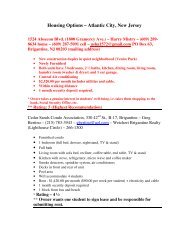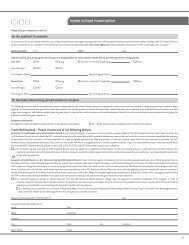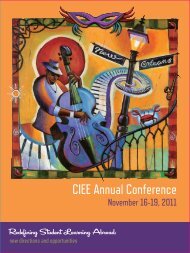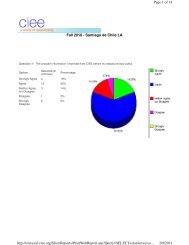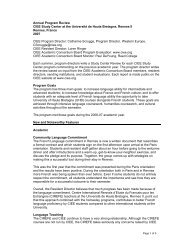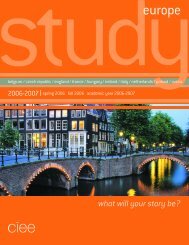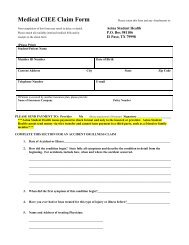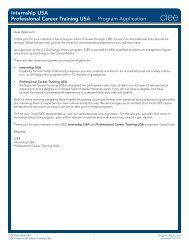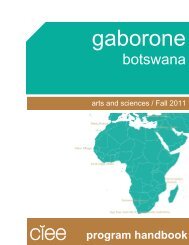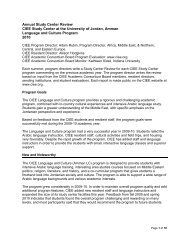Formulating Qualitative Assessment Questionnaires Appropriate to
Formulating Qualitative Assessment Questionnaires Appropriate to
Formulating Qualitative Assessment Questionnaires Appropriate to
- No tags were found...
Create successful ePaper yourself
Turn your PDF publications into a flip-book with our unique Google optimized e-Paper software.
Alignment and Accountability<strong>Formulating</strong> <strong>Qualitative</strong><strong>Assessment</strong> <strong>Questionnaires</strong>Presenter: Lilli EngleAmerican University Center of Provence, FranceFacilita<strong>to</strong>rs:Micheal Vande Berg, CIEE & Patricia Martin, SwarthmoreCollegeCIEE ConferencePhiladelphia, Nov. 2010
Reconciliation of OppositesConsumer contentmen<strong>to</strong>rEducational challenge
Reconciliation of OppositesSatisfaction-based questionnaires oftensimply refer students back <strong>to</strong> their ownpre-departure expectations
Reconciliation of OppositesStudents are asked <strong>to</strong> examine the qualityof their term abroad through the lens ofaccepted American standards**of teaching style, internet access, staff availability, housing comfort
Reconciliation of OppositesDifficult choiceCater <strong>to</strong> familiar client-centered expectations?or …
Reconciliation of OppositesStretch the limitsof what a student can appreciate in the name ofan educational experience by its very natureand purpose different from that at home
Reconciliation of OppositesStudent interest and satisfactionare essential <strong>to</strong> program survival
Reconciliation of OppositesToday’s challengeBring more appropriate criteria <strong>to</strong>the consideration of “satisfaction”
Reconciliation of OppositesCriteria more in keeping withthe ideals of intl. education**Founded on the rigors, risks, and rewards of authentic intercultural experience
Assessing “Quality”in a Cross-Cultural ContextOutside the ethnocentric sphere ofaccepted cultural norms, whatvalue or meaning do the followingqualitative terms carry?
Assessing “Quality”in a Cross-Cultural ContextThe instruc<strong>to</strong>rs were effectiveThe program was intellectually challengingI am satisfied with my study abroad experience
Assessing “Quality”in a Cross-Cultural ContextTo avoid the pitfall of ethnocentricjudgment, questioning may takeanother form…
Assessing “Quality”in a Cross-Cultural ContextAsking for more specific indicationsof how the students lived andbenefitted from the experience theprogram intentionally structured forthem
Aligning Actions and IdealsClarityof mission and purposeis key
Aligning Actions and Ideals1IntentionMission Statement4<strong>Assessment</strong>EvaluationRecorded Outcomes2PerformanceProgram Implementation& Design3ResultsStudent Learning& Development
Aligning Actions and IdealsThe choice and formulation of questionsset the criteria for qualitative judgmentbased on the educational goals ofthe individual program
Engaging the ProcessConfirm the program’s mission statementConsider and list learning goalsDefine program componentsArticulate what each component intends <strong>to</strong> achieveEvaluate cross-cultural challenges per componentEstablish criteria of student engagement
Part I: Defining Mission, Goalsand Program DesignDefine:goalscomponentschallengesand
Part II: Aligning Components,Goals, Challenges, and QuestionsTargeting goals and outcomesBy implementing this component, whatdid the program hope <strong>to</strong> achieve?
Part II: Aligning Components,Goals, Challenges, and QuestionsAction VerbsTo encourage…To provide…To develop…To establish a link…
Part II: Aligning Components,Goals, Challenges and QuestionsEcho the objectivesin question formRemember, questions serve <strong>to</strong> assess <strong>to</strong> what extentthe program succeeded in realizing its goals
Part II: Aligning Components,Goals, Challenges and QuestionsQuestion:To what extent did the academicprogram establish a link between thecourse content and the study abroadlocation?
Part II: Aligning Components,Goals, Challenges and QuestionsIdentifyAdaptational challengesWeighing in the balance specific program contentand projected level of student preparedness
Part II: Aligning Components,Goals, Challenges and QuestionsEcho the challengesin question formChallenge: Adapting <strong>to</strong> a different teaching styleQuestion: To what extent were you able <strong>to</strong> adapt <strong>to</strong>the more lecture-based teaching style of your hostnational professors?
Part III:The Ideal Student ComponentTargeting abstract student goalsWhat would the goals of anideal student be?
Part III:The Ideal Student ComponentList the general abstractstudent goals• Learn the host language• Cultivate friendships…
Part III:The Ideal Student ComponentTargeting behaviorWhat would the ideal studentwith this goal actually do?
Part III:The Ideal Student ComponentAction Verbs• Engage host nationals inconversation whenever possible• Read local press, watch local TV
Part III:The Ideal Student ComponentEcho student ideals inquestion form:In order <strong>to</strong> maximize my learning of the hostlanguage, I (check all that apply)• Engaged host nationals in conversation• Read local press• Watched local TV
RecapThe ideal questionnaire has at its corea clear vision of what the program is trying <strong>to</strong> achieve.Its questions reflect:• Intention: The goals of an ideal program• Performance: What that ideal program should do or provide• Results: What are the ideal outcomes• Evaluation/assessment : What does the ideal student* gain from theexperience and how?*Criteria for the ideal student : motivation, attitude, investment, effort, performance, growth
RecapEvaluating the questions themselves:• In what way is the question/answer meaningful <strong>to</strong> the program or <strong>to</strong> thehome university?• Does the question elicit the judgment of an empowered-consumer?• Are program goals and desired outcomes inherent in the question?• Is the responsibility of the student implicated in the evaluation of theexperience?• Are the standards of evaluation cross-culturally sensitive or weighted byUS standards or expectations?• Does the question invite criticism or negativity or simply leave room forstudent comments?
Questions: Overall ProgramExample I• How do you rate the program ?• Any suggestions for improvement ?• Any elements of the program that you would change?Example II– Consumer-based questions– Ethnocentric questions• Program staff members were accessibleECQCBQ• Each portion of the program built upon previous portions• Communication about program changes, activities, etc. was timelyand clear.
Questions: Overall ProgramExample III– Goal-based questionsEvaluate the amount of growth you experiencedin the following areas:GBQ• Understanding of different cultures• Different perspective on American culture• Greater understanding of the US in world affairs and his<strong>to</strong>ry• Different perspective on your ethnic heritage• Understanding of your faith• Self-awareness• Maturity and self-confidence• Interpersonal skills and the ability <strong>to</strong> adapt• Intellectual development in the liberal artsSliding scale from 1-5 (from Great Growth <strong>to</strong> No Growth and Not Applicable)
Questions: AcademicsExample I – Consumer-based questionsRate the professor*• Quality of instruction• Attitude <strong>to</strong>wards studentsCBQ• Accessible <strong>to</strong> students?Example II – Ethnocentric questionsPlease rate each course according <strong>to</strong> the following criteria:• Quality of the course*• <strong>Appropriate</strong>ness of exams/assignments*• Level of difficulty as compared <strong>to</strong> home university course***Sliding scale from 1-5 (from Exceptional <strong>to</strong> Poor)**Sliding scale from 1-3 (from More Difficult <strong>to</strong> Less Difficult)ECQ
Questions: AcademicsExample III– Goal-based questions• Classes provided me with a greater depth of knowledge andunderstanding pertinent <strong>to</strong> my liberal arts education.Strongly agree / Agree / Not sure / Disagree• The program facilitated my ability <strong>to</strong> perceive the influence of cultureon myself and on others, and <strong>to</strong> interpret meaning from within acultural context.Strongly agree / Agree / Not sure / Disagree• The program motivated me <strong>to</strong> observe my own behavior and modifyit so that it becomes appropriate <strong>to</strong> culturally different situations.Strongly agree / Agree / Not sure / DisagreeGBQ
Questions: HousingExample I– Consumer-based questionsCBQ• Should we continue <strong>to</strong> use this housing situation?• Would you recommend that we retain this family in the future? Ifnot, why not?Example II– Ethnocentric questions• On a scale from one <strong>to</strong> ten, ten being the highest, how would yourank your host family?ECQ• What were the positive and negative aspects of your stay with thishost family?
Questions: HousingExample III– Goal-based questions• My homestay enhanced my learning about the culture• My homestay family included me in their daily life• My homestay family provided a forum for discussion and sharingStrongly agree / Agree / Not sure / DisagreeGBQ
6 Step Collective ExerciseBased on the provided program description: List the learning goals of each component ACTION VERBS! Echo the objectives in question formQuestions that assess <strong>to</strong> what extent the program succeeded in realizing itsprojected goals Identify the students’ adaptational challenges relative <strong>to</strong> thiscomponent Echo the challenges in question form List what the ideal student would do <strong>to</strong> achieve the targetedlearning goals Echo ideal student engagement in question form
Sample Program DescriptionSemester-long Hybrid ProgramMission StatementOffer motivated students an environment of authentic interculturallearning both inside and outside the classroomLearning Goals• Help students adapt <strong>to</strong> a variety of teaching and learning styles• Foster the building of meaningful relationships with host nationals• Optimize target language acquisition• Challenge students <strong>to</strong> become the co-crea<strong>to</strong>rs of their experience abroad
Sample Program Components1. Individual homestay placement2. Community service option3. Membership in a local club or sport’s team4. Language pledge5. Courses taught by local faculty6. Direct enrollment option at local universityPresenter: Lilli EngleAmerican University Center of Provence, FranceFacilita<strong>to</strong>rs:Micheal Vande Berg, CIEE & Patricia Martin, SwarthmoreCollegeCIEE ConferencePhiladelphia, Nov. 2010
Benefits <strong>to</strong> the ProfessionThe process of alignment and accountability: Clearly defines program commitment and learning objectives Validates the level of adaptational challenge for the student Implicates student responsibility in the co-creation of theexperience and its learning outcomesPresenter: Lilli EngleAmerican University Center of Provence, FranceFacilita<strong>to</strong>rs:Micheal Vande Berg, CIEE & Patricia Martin, SwarthmoreCollegeCIEE ConferencePhiladelphia, Nov. 2010
In depthFor more regarding the outlined process of alignmentand accountability:Forum on Education Abroad, Standards of Good Practice on-line <strong>to</strong>olkitwww.forumea.org for a complete handbookUpcoming publication: Frontiers: The Interdisiplincary Journal of StudyAbroad, The Rewards of Designing <strong>Qualitative</strong> <strong>Assessment</strong> <strong>Questionnaires</strong><strong>Appropriate</strong> <strong>to</strong> Study Abroad, Fall 2011.Presenter: Lilli EngleAmerican University Center of Provence, FranceFacilita<strong>to</strong>rs:Micheal Vande Berg, CIEE & Patricia Martin, SwarthmoreCollegeCIEE ConferencePhiladelphia, Nov. 2010



